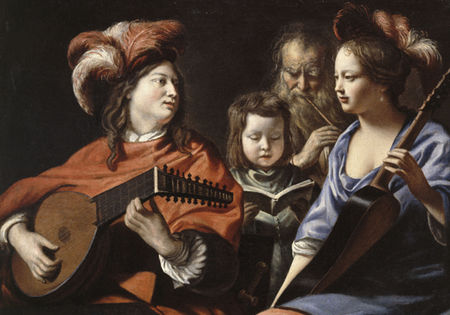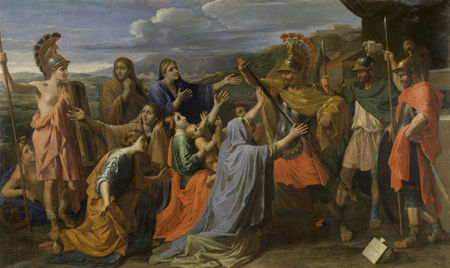"Rubens, Poussin et les peintres du XVIIe siècle" @ Musée Jacquemart-André
Les frères Le Nain - Le Concert - 77 x 87 cm - Musée municipal, Laon - © RMN / Hervé Lewandowski
Cette exposition rassemble une soixantaine de tableaux issus de grandes collections privées et de collections publiques européennes (Musées des beaux-arts de Lille, Nantes, Rennes, Oxford, Liège…). Elle offre une vision inédite de deux grands mouvements artistiques apparus au XVIIe siècle : la peinture baroque flamande dont Rubens est le chef de file et l’école classique française, emmenée par Poussin et de leurs relations croisées. Le Musée Jacquemart-André se propose ainsi d’écrire une nouvelle page de l’histoire de l’art.
UNE EXPOSITION DECOUVERTE
L’exposition s’attache en premier lieu à rendre compte de l’importance du courant flamand en France au début du XVIIe siècle, en présentant les œuvres des grands artistes présents sur la scène artistique française (Rubens, Pourbus, van Thulden…). La confrontation de leurs tableaux avec ceux des frères Le Nain ou de Lubin Baugin témoigne de la forte influence de l’école baroque flamande sur les artistes français.
La suite du parcours est consacrée à l’essor de l’art classique français pendant la seconde moitié du XVIIe siècle. Elle présente de nouveaux modèles picturaux, développés en France par Nicolas Poussin, Laurent de La Hyre, Eustache Le Sueur ou Charles Le Brun, avant d’être adoptés par des artistes flamands tels que Bertholet Flemalle, Gérard de Lairesse… C’est sur cette évocation que s’achève l’exposition, témoignant ainsi du renversement d’influence qui s’est opéré entre ces deux écoles au cours du XVIIe siècle.
Eustache Le Sueur - Allégorie d’un ministre parfait ou Le Ministre d’État et ses attributs (détail) - 85 x 72 cm - Musée des beaux-arts, Dunkerque - © Direction des Musée de Dunkerque, MBA, Ph. Claude Thériez
L’EMPREINTE DE RUBENS A PARIS ET LA DIFFUSION DE LA PEINTURE FLAMANDE EN FRANCE
Le grand maître du baroque, Pierre-Paul Rubens, arrive à Paris en 1625 avec une série de tableaux sur la vie de Marie de Médicis, reine de France et veuve d’Henri IV. Commandé quatre ans auparavant par cette dernière, cet ensemble imposant composé de 24 toiles était destiné à orner l’aile occidentale du palais du Luxembourg à Paris. Il est aujourd’hui présenté au Louvre.
Au début du XVIIe siècle, 70 % de la production artistique anversoise est exportée, dont une grande partie vers la France. À Paris, la foire du bourg Saint-Germain des Prés, animée par des marchands nordiques, diffuse un grand nombre d’œuvres flamandes. Les artistes et les commanditaires français y ont donc accès et y prennent goût.
Nicolas Poussin - Coriolan vaincu par sa femme et sa mère - 116 x 196 cm - Musée municipal Nicolas Poussin, Les Andelys - © RMN / Christian Jean
UNE PREDOMINANCE FLAMANDE SUR LA SCENE ARTISTIQUE FRANCAISE
Sous le règne d’Henri IV, puis sous la régence de Marie de Médicis, les artistes flamands, Pierre-Paul Rubens en tête, obtiennent une grande partie des commandes royales : Philippe de Champaigne dans le domaine du portrait ou Frans Snyders dans celui de l’art animalier.
Cette forte présence en France incite des artistes français à adopter les sujets et les modèles flamands, comme les frères Le Nain dans le domaine de la scène de genre.
Gaspar Duguet - Paysage d’orage - 74 x 99 cm - Musée des beaux-arts, Chartres - © Musée des beaux-arts de Chartres
LA PEINTURE FRANCAISE, NOUVELLE REFERENCE POUR LES ARTISTES FLAMANDS
Peu à peu, la France se constitue une identité culturelle propre qui va influencer de nombreux artistes, notamment les flamands. Attirés par le potentiel énorme du marché français et la magnificence de Louis XIII puis de Louis XIV, des artistes de la principauté de Liège tels Bertholet Flemalle ou Gérard de Lairesse se rendent à Paris pour se perfectionner et apprendre les techniques picturales françaises.
Juste D'Egmont, Le Pape Paul II ordonne cardinal, Charles de Lorraine à l’âge de 23 ans, 1635. Huile sur bois, 56,5 x 53,3 cm. Collection privée, Paris © Luiz Gonzalez
PARIS.- This exhibition assembles around sixty paintings from some of the best private and public collections in Europe (Art museums in Lille, Nantes, Rennes, Oxford, Liège, and more). It offers a unique view of two great artistic movements of the 17th century: Flemish Baroque painting, of which Rubens is the chief protagonist, and the French Classical school led by Poussin and the influence they had on each other. The Jacquemart-André Museum has set out to write a new page in the history of art.
An exhibition of discovery
The exhibition’s primary aim is to highlight the importance of the Flemish movement in France at the beginning of the 17th century by showing the works of the great artists who were present on the French artistic scene at the time (Rubens, Pourbus, van Thulden, etc.). A comparison of their paintings with those of the Le Nain brothers or Lubin Baugin reveals the strong influence of the Flemish Baroque school on French artists.
The rest of the exhibition is devoted to the rise of French Classical art during the second half of the 17th century. It presents some new pictorial models, developed in France by Nicolas Poussin, Laurent de La Hyre, Eustache Le Sueur and Charles Le Brun, before being adopted by Flemish artists such as Bertholet Flemalle and Gérard de Lairesse. This is the note on which the exhibition finishes, thereby highlighting the reversal of influence which operated between these two schools during the 17th century.
The imprint of Rubens in Paris and the spread of Flemish painting in France
The grand master of the Baroque, Pierre-Paul Rubens, arrived in Paris in 1625 with his series of canvases depicting the life of Mary of Medicis, Queen of France and widow of Henri IV. Commissioned four years earlier by the Queen, this imposing series of 24 pieces was destined to decorate the west wing of the Luxembourg palace in Paris. Today it hangs in the Louvre.
At the start of the 17th century, 70% of Antwerp’s artistic production was exported, a large portion of it to France. In Paris, Saint-Germain des Prés village fair, hosted by Nordic merchants, sold a great many Flemish works of art. As a result, French artists and their sponsors came into contact with the Flemish style and acquired a taste for it.
Flemish dominance on the French artistic scene
Under the reign of Henri IV, and then the regency of Mary of Medicis, Flemish painters, with Pierre-Paul Rubens foremost among them, obtained the lion’s share of royal commissions, including Philippe de Champaigne for portraits and Frans Snyders for animal art.
This strong presence in France motivated French artists like the Le Nain brothers to adopt Flemish subjects and models in the field of genre painting.
The rise of French Classicism
The heyday of an artistic style from Flanders was succeeded by an “ideal” style of art started by Nicolas Poussin which exerted a poetic power that extended well beyond France’s borders.
In fact, during the reign of Louis XIII, a truly French pictorial identity was forged, appearing simultaneously in the work of artists like Nicolas Poussin, who remained profoundly marked by his time in Rome, and other artists who never left Paris, such as Eustache Le Sueur and Laurent de La Hyre. They all developed a new pictorial language: French Classicism.
French painting, a new point of reference for Flemish artists
Little by little, France built its own cultural identity which would influence many artists, in particular the Flemish. Attracted by the enormous potential of the French market and the magnificence of the court of Louis XIII and his successor Louis XIV, artists from the principality of Liège including Bertholet Flemalle and Gérard de Lairesse came to Paris to perfect and learn French pictorial techniques.
Philippe de Champaigne (1602-1674), Céphale et Procris dans un paysage, Vers 1630. Huile sur bois, 103,5 x 170,5 cm. Collection privée, Paris © Studio Sébert Photographes

/https%3A%2F%2Fprofilepics.canalblog.com%2Fprofilepics%2F1%2F0%2F100183.jpg)
/https%3A%2F%2Fstorage.canalblog.com%2F03%2F02%2F119589%2F96711876_o.jpg)
/https%3A%2F%2Fstorage.canalblog.com%2F11%2F31%2F119589%2F94773502_o.jpg)
/https%3A%2F%2Fstorage.canalblog.com%2F20%2F83%2F119589%2F94772815_o.jpg)
/https%3A%2F%2Fstorage.canalblog.com%2F26%2F72%2F119589%2F75604929_o.jpg)
/https%3A%2F%2Fstorage.canalblog.com%2F59%2F60%2F119589%2F26458628_o.jpg)








/http%3A%2F%2Fstorage.canalblog.com%2F18%2F20%2F119589%2F121102965_o.jpg)
/http%3A%2F%2Fstorage.canalblog.com%2F41%2F55%2F119589%2F71222864_o.jpg)
/http%3A%2F%2Fstorage.canalblog.com%2F33%2F97%2F577050%2F39651117_p.jpg)
/http%3A%2F%2Fstorage.canalblog.com%2F39%2F52%2F119589%2F30807657_o.jpg)